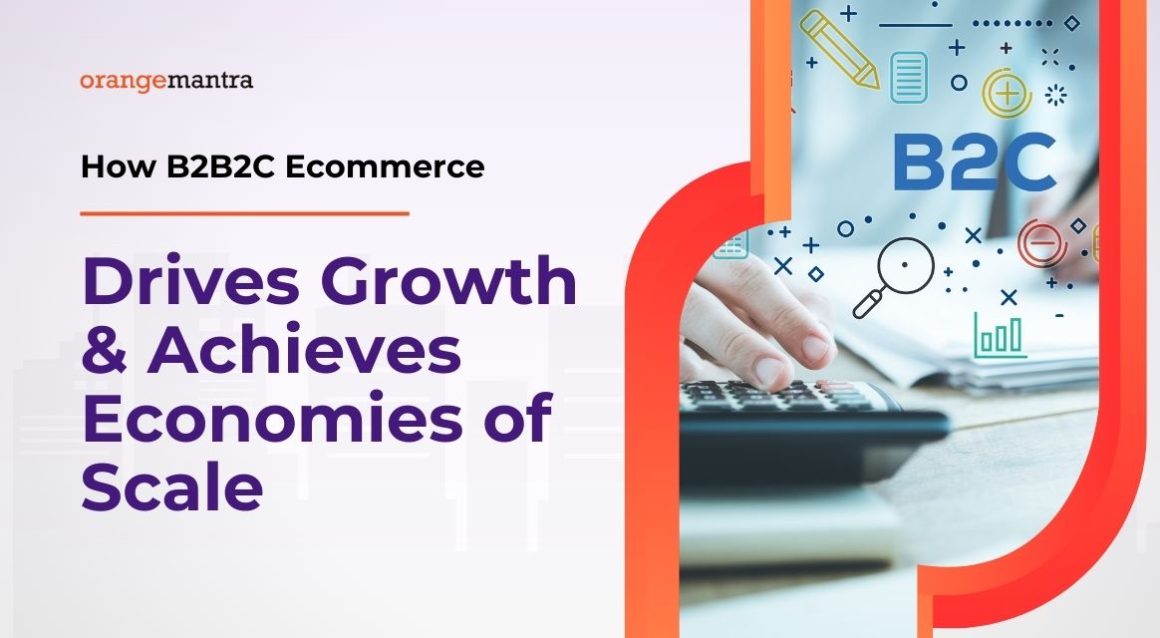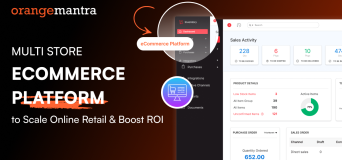Businesses always try different ways to expand their reach while optimizing costs. This has become more important after today’s digital-first economy. One of the most effective models driving this transformation is B2B2C ecommerce.
It’s possible that you haven’t heard of this before. But as you read further you’ll realize that you have already seen this model working. B2B2C ecommerce is a hybrid approach. It combines B2B and B2C strategies.
What happens in traditional B2B models is that manufacturers or wholesalers sell exclusively to retailers. But B2B2C eCommerce allows companies to sell directly to customers. At the same time, they still work with partners like online stores or distributors.
This article explains how B2B2C eCommerce helps businesses grow faster. It also covers the challenges and best ways to succeed in the long run.
Table of Contents
Understanding B2B2C Ecommerce and Economies of Scale
What makes B2B2C particularly powerful is its ability to tackle economies of scale. It saves money as businesses grow. By producing more, improving delivery, and refining marketing, companies cut costs and earn more profit.
What is B2B2C Ecommerce?
B2B2C ecommerce platform joins traditional wholesale and D2C sales. It lets brands sell through online stores while staying connected with customers.
This approach helps businesses reach more customers. At the same time, they still control branding, pricing, and customer experience.
Nike sells its products on Amazon and its own website. This helps Nike grow without depending much on middlemen and improve marketing with customer data.
What Are Economies of Scale?
Economies of scale happen when businesses save money as they grow. These savings usually come in two main ways:
Internal economies of scale – It means cost savings within the company. It can be bulk purchasing and efficient workforce management.
External economies of scale – These are cost savings from industry-wide improvements. For example, lower shipping costs from shared warehouses or better supplier prices as demand grows.
B2B2C eCommerce platform benefits from these cost savings. This is because it merges large scale B2B distribution with the agility of direct consumer engagement. Check the global market size of B2B2C ecommerce below as reported by Zion Market Research.
How B2B2C Ecommerce Achieves Economies of Scale?
The scalability of B2B2C ecommerce lies in its ability to lower costs while expanding market reach. Here’s how businesses achieve economies of scale in this model:
Lower Cost Per Unit Through Bulk Operations
One of the primary ways B2B2C companies scale is by reducing the cost per unit through mass production and streamlined supply chains. Since businesses serve both B2B and B2C customers, they can consolidate inventory and negotiate better supplier pricing.
Take the example of a global beauty brand that sells through its website and retail partners like Amazon. This brand can manufacture in bulk which reduces per unit costs, and products will also be available across multiple channels.
Technology & Automation for Scaling
Automation plays an important role in reducing costs while managing a growing customer base. AI is helping in predict demand analysis for inventory management. This makes sure products are always in stock without overproduction.
Similarly, automated chatbots and customer service platforms reduce the need for large support teams which improve operational efficiency.
Take Shopify powered brands for example. Many uses AI to recommend products based on consumer behavior. This increases conversion rates without additional marketing expenses. These technologies allow businesses to scale customer interactions without proportionally increasing costs.
Lower Customer Acquisition Costs via Omnichannel Marketing
One of the biggest challenges in ecommerce is high customer acquisition costs. However, B2B2C models leverage omnichannel marketing. It means selling through multiple digital mediums such as social media, marketplaces, and D2C websites. This strategy reduces reliance on expensive paid ads.
Let’s take an example of one of the growing B2B2C companies in India. Mamaearth is a skincare brand that runs Instagram campaigns and also sells through Amazon and other retail partners. It is one of the best B2B2C examples we can tell you right now.
Mamaearth has diversified its reach and reduced customer acquisition costs while increasing revenue potential.
Streamlined Logistics & Distribution
Efficient logistics helps lower costs. Many B2B2C ecommerce platforms use third party logistics for storage and delivery. Amazon’s Fulfillment by Amazon is a great example.
Sellers store products in Amazon’s warehouses, and Amazon handles shipping and customer service. Outsourcing logistics reduces costs, speeds up shipping, and improves customer satisfaction.
Industry Trends in B2B2C Ecommerce
B2B2C ecommerce will continue to grow. Several key trends are shaping the industry:
Smarter Shopping with AI – Businesses use AI to suggest products and set better prices.
Rise of Marketplaces & D2C Expansion – Brands are selling directly to customers while still using marketplaces.
Subscription & Membership Models – Subscription based ecommerce like Amazon Prime keeps customers coming back.
Sustainability & Ethical Sourcing – People want greener products. Companies are being pushed to optimize supply chains for minimal waste.
Challenges in Scaling B2B2C Ecommerce
B2B2C eCommerce helps businesses grow, but it also has some tricky parts:
Keeping the Brand the Same – When selling on big websites like Amazon, businesses can’t control how their products look or how customers feel. They need to make sure their brand stays strong everywhere.
Setting Fair Prices – Businesses sell to stores and directly to customers. If they make prices too low online, stores won’t want to sell their products. If prices are too high, customers might go somewhere else.
Handling Deliveries – Sending lots of orders to many places can be hard. Some companies get help from shipping services, but it takes planning to keep costs low and deliveries fast.
Making Customers Happy – Whether people buy from a store or online, they expect good service. Businesses need good support and fast responses to keep customers coming back.
Best Practices for Achieving Economies of Scale in B2B2C
If companies want to successfully scale a B2B2C business, here are some strategies they can adopt:
Invest in Scalable Technology – AI powered ecommerce platforms like Shopify Plus and Magento help automate operations and improve efficiency.
Optimize Supply Chain & Fulfillment – Leveraging 3PLs and real time inventory management for faster deliveries at lower costs.
Strengthen Partner & Marketplace Strategy – Maintaining a balanced D2C and marketplace approach prevents over-reliance on any single channel.
Use Data for Smarter Decision-Making – Customer analytics help optimize marketing campaigns and inventory management, reducing unnecessary expenses.
Comparison of B2B, B2C, and B2B2C Business Models
This table summarizes the models, aiding in understanding B2B2C’s unique position.
| Model | Description | Key Advantage | Example |
| B2B | Business sells to other businesses | Large volume transactions, bulk discounts | Manufacturer to retailer |
| B2C | Business sells directly to consumers | Direct customer relationship | Online retail store |
| B2B2C | Business A partners with Business B to sell to C | Access to B’s customer base, cost efficiency | Amazon Marketplace sellers |
The Next Phase of B2B2C Growth
B2B2C ecommerce will continue to evolve with technological advancements:
- AI automation will further optimize logistics and customer interactions.
- Metaverse & AR shopping will provide immersive digital shopping experiences.
- Blockchain & smart contracts will improve supply chain transparency and security.
- 5G adoption will make faster and more seamless ecommerce transactions.
Conclusion
B2B2C eCommerce helps businesses grow while saving money. It lets them reach more customers, use AI to make smart choices, and manage their supply chains better. But companies need to protect their brand and set fair prices to succeed. If a business wants to expand, the B2B2C business model is great to consider.
FAQs
Q1. What is B2B2C Ecommerce?
B2B2C meaning is Business-to-Business-to-Consumer ecommerce. In this model, companies sell products through retailers or online marketplaces while also selling directly to customers. This helps businesses grow faster, save money, and build stronger relationships with their customers.
Q2. How Does B2B2C Ecommerce Help Businesses?
B2B2C ecommerce helps businesses reach more customers, lower costs, and improve delivery processes. It allows companies to sell in large amounts (B2B) but still stay connected with customers (B2C). This leads to more profits and better brand control.
Q3. How Can Businesses Grow with B2B2C Ecommerce?
To grow, businesses should use automation, AI, and smart logistics. Working with 3rd party delivery partners and online marketplaces while also selling directly to customers helps businesses expand and stay competitive.






